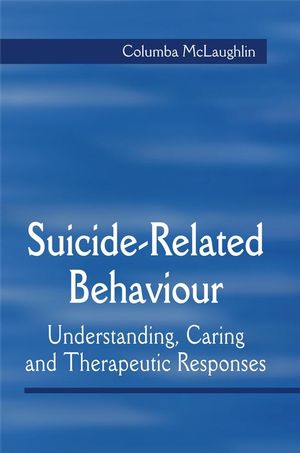Suicide-Related Behaviour: Understanding, Caring and Therapeutic ResponsesISBN: 978-1-86156-508-2
Paperback
230 pages
September 2007
 |
||||||
Chapter 1 A personal reflection on suicide-related behaviour.
Chapter 2 Contemporary Issues.
i) Suicide-Related Behaviour – The Ultimate Contradiction.
ii) Ethical issues in Suicide-Related Behaviour.
iii) Legal and Religious Laws.
iv) Attitudes to Suicide-Related Behaviour.
v) Competency in Interpersonal Skills.
Chapter 3 Clarifying the Terminology.
i) The problem with too many terms.
ii) Suicide Intent.
iii) Lethality of Method.
iv)Ambivalence.
v) Risk-Taking Behaviour.
vi) The concept of Suicide-Related Behaviour.
vii) Death orientated suicide-related behaviour.
viii) Life orientated suicide-related behaviour.
Chapter 4 Suicide-Related Behaviour.
i) What is suicide-Related Behaviour.
ii) Understanding suicide-related ideation.
iii) Understanding Attempted Suicide.
iv) Understanding Suicide.
v) Understanding Self-Harm.
vi) Repetitive Self-Harm.
Chapter 5 The Descent into Crisis.
i) Why Suicide-Related Behaviour.
ii) Theoretical Perspectives on Stressors.
iii) The biological perspective.
iv) The psychological perspective.
v) The psychoanalytical perspective.
vi) The psychodynamic developmental perspective.
vii) The cognitive perspective.
viii) The situational or stressful life events perspective.
ix) The social integration perspective.
x) The mental ill-health perspective.
xi) Crisis.
Chapter 6 Responding to Crisis.
i) A person’s response to crisis..
ii) The biological response to stressors.
iii) Coping abilities as buffers against stressors.
iv) Cognitive and emotional responses as buffers against stressors.
v) Social support as a buffer against stressors.
vi) Positive attitude as a buffer against stressors.
vii) Individual differences as buffers against stressors.
viii) The person’s behavioural response to crisis.
ix) Help seeking behaviour - Contact with the caring services.
x) Stressor resolved.
xi) Stressor unresolved - Crisis.
Chapter 7 Caring Responses to suicide-related behaviour.
i) The case for a caring response.
ii) Personal qualities of the practitioner.
iii) The skills required in the therapeutic relationship.
iv) An example of a caring response.
Chapter 8 Therapeutic Responses to suicide-related behaviour.
i) A medical response – Medications..
ii) A therapeutic response.
Additional notes.
The assessment..
Set induction.
Assess events leading up to admission.
Assess personal history.
The care plan.
iii) A therapeutic response – Problem management..
iv) A therapeutic response – Challenging negative cognitions..
The initial assessment.
Making the A – C link.
Making the B – C link.
v) A caring and therapeutic response to self-harm..
Reference List.
Subject Index.



